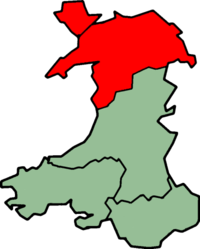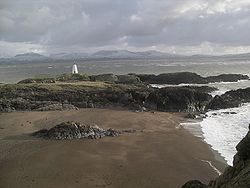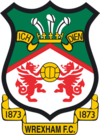- North Wales
-
North Wales (Welsh: Gogledd Cymru) is the northernmost unofficial region of Wales. It is bordered to the south by the counties of Ceredigion and Powys in Mid Wales and to the east by the counties of Shropshire in the West Midlands and Cheshire in North West England. North Wales is divided in to three traditional regions, viz; Upper Gwynedd (or Gwynedd above the Conwy defined as the area north of the River Dyfi and west of the River Conwy); Lower Gwynedd (or Gwynedd below the Conwy also known as the Perfeddwlad and defined as the region east of the River Conwy and west of the River Dee) and Ynys Môn (or Anglesey), a large island off the north coast.[citation needed].
The southern boundary is arbitrary and its definition may depend on the use being made of the term. For example the boundary of North Wales Police differs from the boundary of the North Wales area of the Environment Agency Wales.
Contents
History
North Wales is steeped in history and was for almost a millennium known as the Kingdom of Gwynedd. The mountainous stronghold of Snowdonia formed the nucleus of that realm and would become the last redoubt of independent Wales — only overcome in 1283. To this day it remains a stronghold of the Welsh language and a centre for Welsh national and cultural identity.
World Heritage Sites
North Wales is home to two of the three UNESCO World Heritage Sites in Wales. These are Pontcysyllte Aqueduct and canal[1] and, collectively, the Edwardian castles and town walls of the region[2] which comprise those at Caernarfon, Beaumaris,[3] Conwy and Harlech.
Political divisions
The region is made up of the following administrative areas:
- the county borough of Wrexham (Wrecsam)
- the county of Flintshire (Sir y Fflint)
- the county of Denbighshire (Sir Ddinbych)
- the county borough of Conwy
- the county of Gwynedd
- the county of the Isle of Anglesey (Ynys Môn)
Related constituencies
North Wales was a European Parliament constituency until 1999. Currently, there is an electoral region for the National Assembly for Wales with the name (used, in parallel with the smaller constituencies, to elect top-up members under the Additional Member System), which covers the north-east of Wales (specifically the entire area of the former pre-1996 county of Clwyd) as well as the Northern-most coastal areas of north-western Wales; the rest of North Wales is covered by Mid and West Wales.
Geography
The area is mostly rural with many mountains and valleys. This, in combination with its coast (on the Irish Sea), has ensured that tourism is the principal industry. Farming, which was once the principal economic force in the area, is now much reduced in importance. The average income per capita of the local population is the lowest in the UK and much of the region has EU Objective 1 status.[4]
The eastern part of North Wales contains the most populous areas, with more than 300,000 people living in the areas around Wrexham and Deeside. Wrexham is North Wales' largest town, with a population of 68,000 in 2005. The majority of other settlements are along the coast, including some popular resort towns, such as Rhyl, Llandudno and Pwllheli. The A55 road links these towns cities like Manchester, Liverpool and Birmingham and the port of Holyhead for ferries to Ireland; few routes connect North Wales with South Wales. There are two cathedral cities – Bangor and St. Asaph – and a number of mediaeval castles (e.g., Criccieth, Dolbadarn, Harlech, Caernarfon Castle, Beaumaris, Conwy).
Geology
North Wales has a very diverse and complex geology with Precambrian schists along the Menai Strait and the great Cambrian dome behind Harlech and underlying much of western Snowdonia. In the Ordovician period much volcanism deposited a range of minerals and rocks over the north western parts of Gwynedd whilst to the east of the River Conwy lies a large area of upland rolling hills underlain by the Silurian mudstones and grits comprising the Denbigh and Migneint Moors. To the east, around Llangollen, to the north on Halkyn Mountain and the Great Orme and in eastern Anglesey are beds of limestone from which metals have been mined since pre-Roman times. Added to all this are the complexities posed by Parys Mountain and the outcrops of unusual minerals such as Jasper and Mona Marble which make the area of special interest to geologists.
Language
North Wales has a distinct regional identity. Its dialect of the Welsh language differs from that of other regions such as South Wales in some ways; for example llefrith is used in most of the North instead of llaeth for "milk"; a simple sentence such as go upstairs now might be Dos i fyny'r grisiau rŵan in North Wales, where it might be Cer lan y stâr nawr in South Wales. Colloquially, a person from North Wales (especially one who speaks with this dialect or accent) is known as a North Walian, or a Gog (from the Welsh gogledd, meaning "north").
Local media
Newspapers
Two daily newspapers are published in North Wales. The region-wide North Wales edition of the Daily Post, based at Trinity Mirror's offices in Llandudno Junction, is distributed from Monday to Saturday, whilst The Leader (formerly the Evening Leader) publishes three editions for Wrexham, Chester and Flintshire and is based at the headquarters of NWN Media in Mold.
Additionally, nine weekly newspapers provide local and community news:
Trinity Mirror titles
- Caernarfon and Denbigh Herald (Arfon and Dwyfor editions)
- The Mail (Bangor/Anglesey and Holyhead/Anglesey editions)
- North Wales Weekly News (General, Colwyn Bay and Conwy Valley editions)
NWN Media titles
- Denbighshire Free Press
- Flintshire Standard
- The Journal (Rhyl, Prestatyn and Abergele editions)
- North Wales Chronicle (North Gwynedd and Anglesey)
- North Wales Pioneer (Llandudno and Colwyn Bay editions)
- Wrexham Leader
The weekly Aberyswyth-based Cambrian News covers southern Gwynedd and publishes separate editions for the Arfon/Dwyfor and Meirionydd districts.
A weekly Welsh-language newspaper, Y Cymro is published each week by the Cambrian News from its Porthmadog office alongside two localised Welsh titles, Y Cyfnod (Bala) and Y Dydd (Dolgellau). Yr Herald Gymraeg is distributed by Trinity Mirror as a pull-out section in the Wednesday edition of the Daily Post. There are also 24 Papurau Bro (area papers) providing community news and generally published each month.
Radio
Although no BBC local radio stations exist for North Wales, the Corporation's national services BBC Radio Wales and BBC Radio Cymru cover the region from its broadcasting centre in Bangor, a smaller studio and newsroom in Wrexham and a satellite studio in Mold.
Three commercial radio stations serve the area — Heart North West and Wales broadcasts local breakfast and drivetime programming for Wrexham, Flintshire, Denbighshire and Conwy county as well as Cheshire and the Wirral with a Welsh language opt-out service for the former Coast FM area on 96.3 FM. Heart Cymru airs an extended local programming service, predominantly in the Welsh language, for Gwynedd and Anglesey. Both stations broadcast from studios in Gwersyllt on the outskirts of Wrexham. Real Radio Wales broadcasts a national service from Cardiff but also operates from a news and advertising office in Wrexham.
Three community radio stations broadcast on FM — Calon FM serving Wrexham County Borough & parts of southern Flintshire, Tudno FM broadcasting to Llandudno & surrounding areas and Point FM serving Rhyl, parts of the Vale of Clwyd and eastern areas of Conwy county. In addition, a fourth community station, Wrexham FM, broadcasts online.
Television
News coverage of North Wales is generally provided within the BBC's Wales Today, Newyddion and Ffeil programmes (the latter two broadcast on S4C) and ITV's Wales Tonight programme. BBC Cymru Wales news teams are based at the Corporation's Bangor, Wrexham and Mold studios while ITV Wales runs a newsroom in Colwyn Bay.
S4C has an administrative office in Caernarfon, where a cluster of independent production companies are also based or partly based including Rondo Media, Cwmni Da, Antena, Owain Roberts Animations and Tinopolis.
Sport
Football
Wrexham F.C. play in the English football league system; having been a member of the Football League for over 80 years, in 2008 they were relegated into the Conference National for the first time in their existence. They remain the highest ranked team in the region, and play at the Racecourse Ground in Wrexham and train at Colliers Park, Gresford. Colwyn Bay F.C. also play in the English pyramid at Conference North level.
There are a number of teams playing within the semi-professional domestic leagues the Welsh Premier League and the Cymru Alliance.
Rugby League
Wales was represented in the European Super League by Crusaders Rugby League, they re-located to Wrexham for the 2010 season from south Wales. They played at the Racecourse Ground and trained at Stansty Park both in Wrexham before folding in 2011.
Rugby Union
In September 2008 it was announced by the Welsh Rugby Union that a development team based in North Wales would be created, with a long term goal of becoming the fifth Welsh Region in the Celtic League.[5] It was envisaged that this would both help the growth of the game in the area, and provide a larger pool of players for the Welsh national team to be selected from.[6]
Attractions
In 2000, The Wales Tourist Board tourist identified the top 10 most visited attractions in the region.[7] They included:
- Llangollen
- Portmeirion
- Caernarfon Castle
- Conwy Castle
- Bodnant Garden
- Llechwedd Slate Caverns
- Swallow Falls
- Great Orme Tramway
- Penrhyn Castle
- Erddig
See also
- Geography of Wales
- South Wales
- West Wales
- Mid Wales
- North Wales Police
- North Wales Fire and Rescue Service
- Kingdom of Gwynedd
References
- ^ Pontcysyllte Aqueduct World Heritage Site, UNESCO
- ^ Castles and Town Walls of King Edward in Gwynedd World Heritage Site, UNESCO
- ^ Beaumaris Castle, Anglesey, A World Heritage Site, http://www.anglesey-today.com/beaumaris-castle.html
- ^ Structural Funds: Eligible areas in region West Wales & The Valleys for Objective 1 between 2000 and 2006, European Commission Regional Policy, http://ec.europa.eu/regional_policy/atlas/united_kingdom/ukl1_en.htm
- ^ "WRU plan for northern development team". The Independent. 9 September 2008. http://www.independent.co.uk/sport/rugby/rugby-union/international/wru-plan-for-northern-development-team-923786.html.
- ^ Crump, Eryl; Rob Griffiths (9 September 2008). "Strongest hint yet that North Wales will be fifth rugby region". Daily Post. http://www.dailypost.co.uk/news/north-wales-news/2008/09/09/a-step-closer-to-joining-rugby-s-elite-55578-21705877/.
- ^ The top 10 attractions in North Wales, http://icnorthwales.icnetwork.co.uk/holidays/topten/
External links
- Ancient Tenures of North WalesPDF PDF book by Alfred Neobard Palmer published in 1910
Categories:- Regions of Wales
- Subdivisions of Wales
Wikimedia Foundation. 2010.



